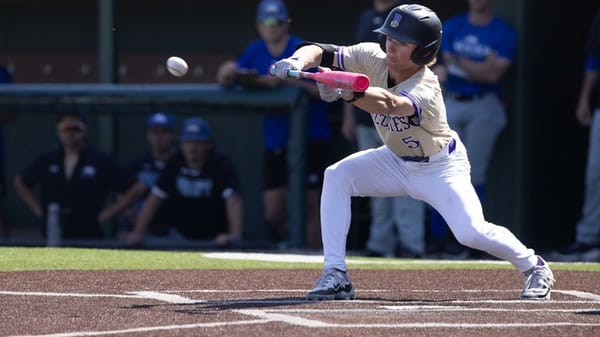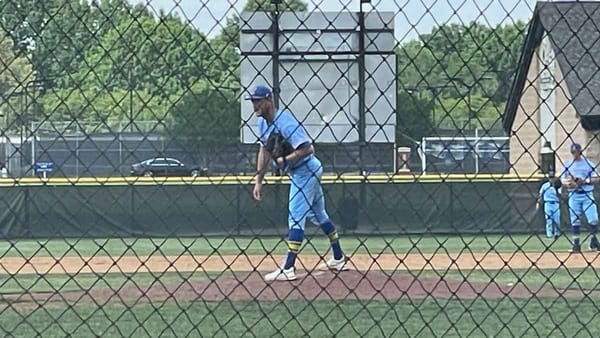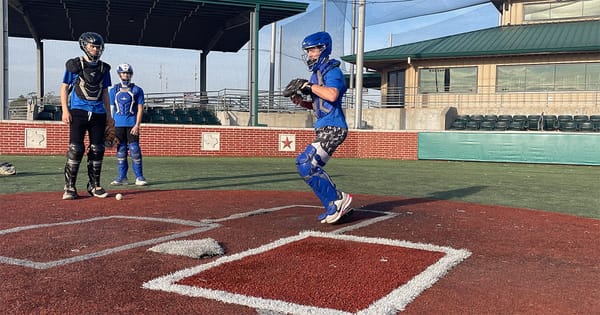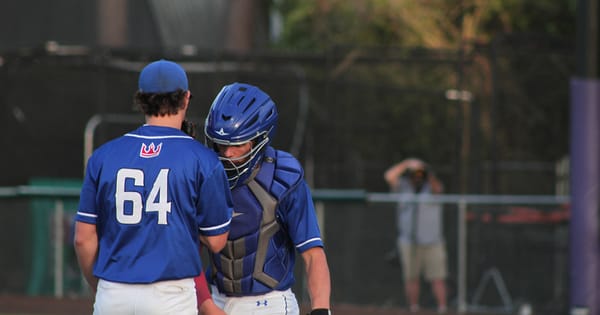An inside look at Tomball Kings tryouts
Twice each year—prior to the spring and fall seasons—we conduct open tryouts for Kings rosters. Let us take you inside our tryout process, so that you will know what to expect and be able to perform at your best.
Times and grades
At each tryout, irrespective of age, we time or grade candidates in these activities:
- Sixty-yard dash
- Push-up form (one or two repetitions, maximum)
- Athleticism
- Infield fielding
- Infield throwing
- Outfield fielding
- Outfield throwing
- Batting
We time the sixty-yard dash and grade the other activities, typically on a scale of one (lowest) to five (highest). Though it rarely happens, we sometimes assign a "zero" grade to a particular activity, e.g., if a player misses every pitch during the batting evaluation. Occasionally, we assign a "plus" grade to an activity, e.g., "3+," if a player falls between customary grading standards for a particular activity.
When we assign grades, we do so on an age-adjusted basis. That is, we compare high school players with other high school players in our competitive market. We do not grade first graders in the same way we evaluate eighth graders.
Scoring
Of the eight activities we listed above that we time or grade, we use only six for scoring players (athleticism, infield fielding, infield throwing, outfield fielding, outfield throwing, and batting). We exclude the time in the sixty-yard dash and grade for push-up form from our scoring system, though still take those activities into account in making final roster decisions.
Given our five-point scale, a player can earn a maximum of thirty points in a tryout (six events at a maximum of five points each).
Ranking
At the conclusion of tryouts, we rank all candidates from the highest overall score to the lowest. In cases of ties, we use the sixty-yard-dash time, push-up-form grade, and other observations (punctuality, appearance, attentiveness, hustle, etc.) to make distinctions. In our experience, players who have studied our guide "How to make the most of your baseball tryout" typically do well when qualitative evaluations are most relevant.
We also draw a line under the last player with a score of eighteen or higher. Eighteen points is equivalent to an average score of "three" in each of the six events and constitutes what we would deem to be the median performance for a given age group. All else being equal, as players move up in age toward their high school years, we tend to become less inclined to offer roster positions to players with total scores below eighteen.
Roster assignments
For high-school-tryout purposes, we use tryouts only to make high-school-program-as-a-whole offers. We do not assign high school players to varsity or sub-varsity rosters until after the commencement of spring training. Also, we have no externally-imposed limits on program size in high school. Our head coach Philip Wilkins will make offers to any number of players he deems advisable, taking into account program competitiveness and player-development needs and resources.
The situation is different in junior high and elementary school. Typically we face league-imposed limits of twelve players per roster in those age divisions. Accordingly, we use the tryout rankings as the basis both for roster assignments and offers.
Commonly—there are exceptions as set forth below—we will assign the top twelve players to one roster, the next twelve players to the next roster, and so forth.
Needs for coaches, pitchers, and catchers form one set of exceptions. Every roster needs coaches, pitchers, and catchers. Thus, we will sometimes override the scoring system to ensure that each roster we form is adequately staffed with coaches, pitchers, and catchers.
We also make exceptions for player-development purposes. Suppose that we graded a first baseman in the top twelve based on tryout score, behind another first baseman who is one year older and more likely to receive the starting nod. In that case, we might assign the younger first baseman to the second-twelve roster, simply so that we can get him adequate repetitions at that position. Alternatively, we might move a player to a different roster simply to get him work at a different position altogether, as we think ahead to high school and what our needs are in that program.
Roster offers
After we have made pro forma roster assignments, we begin making roster offers, typically within twenty-four hours of the conclusion of tryouts. We always make these offers by telephone. We call high school players directly. For junior high and elementary school players, we call the parents. In very rare cases, typically on account of irreconcilable schedule conflicts, we may adjust the roster assignments after we commence making roster offers.
We never share scores, but are always happy to provide qualitative assessments during these conversations.
When we do not make roster offers
We strive to make a place for every junior high and elementary school candidate. Unfortunately—and this is always painful for us—we sometimes cannot extend offers to candidates. This most commonly arises because of roster-size limitations: we have an insufficient number of players to form an additional roster. Less commonly, we will find that a player lacks the ability to defend himself in the field, given the level competition, or otherwise simply needs more experience, speed, or athleticism.
At the high school level, we face no roster-size limitations, but must consider program competitiveness and resources in making roster decisions. In some cases, taking those factors into account, we will decline to extend a roster offer to a high school candidate.
In all cases in which we decline to make a roster offer, however, we always offer encouragement and specific, tailored guidance and other forms of assistance to the athlete and his family. We always hope to see the player at a future tryout and to be able extend a roster offer at that next tryout. And, in fact, we have numerous players in our program who have traveled that very path.
No athlete should let someone else dictate when his playing days are over. He should play and compete for as long as he has love and passion for the game.
Multi-day tryouts
This spring, for the first time, players in high school and junior high will try out over multiple days.
The high school tryout will take place during what is also a traditional week of fall practices for our high school program. Many of the players will already have received roster offers, either from the prior spring or individual tryouts. This gives high school candidates up to five days of work under the guidance of our high school coaches, and our coaches extensive teaching time with candidates.
The junior high program will now take place over two days. This also gives our coaches more teaching time and will allow us to evaluate players under game-like situations at the end of each day.
We are grateful to all who choose to try out with us. Please call John Harris at 512-470-0915 if you need more information or have any questions.



